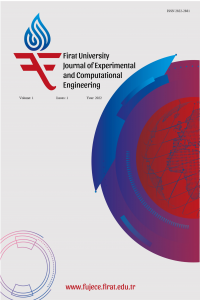Obtaining and modeling the relaxation modulus of self-healing asphalt mixtures
Obtaining and modeling the relaxation modulus of self-healing asphalt mixtures
___
- [1] Hunter R, Self A, Read J. The Shell Bitumen Handbook, 6th edition. London, England, Shell Bitumen, 2015.
- [2] Hu M, Li L, Peng F. "Laboratory investigation of OGFC-5 porous asphalt ultra-thin wearing course". Construction and Building Materials, 219, 101–110, 2019.
- [3] Jia H, Chen H, Sheng Y, Meng J, Cui S, Kim YR, et al. "Effect of laboratory aging on the stiffness and fatigue cracking of asphalt mixture containing bamboo fiber". Journal of Cleaner Production, 333, 130120, 2021.
- [4] Fu L, Jiao Y, Chen X. "Reinforcement evaluation of different fibers on fracture resistance of asphalt mixture based on acoustic emission technique". Construction and Building Materials, 314, 125606, 2022.
- [5] Sun S, Li P, Cheng L, Wang X, Zhang W. "Analysis of skeleton contact stability of graded aggregates system and its effect on slip creep properties of asphalt mixture". Construction and Building Materials, 316, 125911, 2022.
- [6] Zhao X, Sheng Y, Lv H, Jia H, Liu Q, Ji X, et al. "Laboratory investigation on road performances of asphalt mixtures using steel slag and granite as aggregate". Construction and Building Materials, 125655, 2021.
- [7] Karami M, Nikraz H. "Using advanced materials of granular bra modifier binder to ımprove the flexural fatigue performance of asphalt mixtures". Procedia Engineering, 125, 452–460, 2015.
- [8] Wulandari PS, Tjandra D. "Use of crumb rubber as an additive in asphalt concrete mixture". Procedia Engineering, 171, 1384–1389, 2017.
- [9] Apostolidis P, Liu X, Erkens S, Scarpas A. "Evaluation of epoxy modification in bitumen". Construction and Building Materials, 208, 361–368, 2019.
- [10] Muhammed Ertugrul Ç, Mehmet Y, Kök BV, Yalçin E. "Effects of various biochars on the high temperature performance of bituminous binder". In Proceedings of 6th Eurasphalt & Eurobitume Congress. Czech Technical University in Prague, 1-3 June 2016.
- [11] Erkuş Y, Kök BV, Yilmaz M. "Effects of graphite on rheological and conventional properties of bituminous binders". International Journal of Pavement Research and Technology, 10(4), 315–321, 2017.
- [12] Erkuş Y, Kök BV, Yilmaz M. "Evaluation of performance and productivity of bitumen modified by three different additives". Construction and Building Materials, 261, 120553, 2020.
- [13] Vural Kök B, Aydoğmuş E, Yilmaz M, Akpolat M. "Investigation on the properties of new palm-oil-based polyurethane modified bitumen". Construction and Building Materials, 289, 123152, 2021.
- [14] Sun D, Sun G, Zhu X, Guarin A, Li B, Dai Z, et al. "A comprehensive review on self-healing of asphalt materials: Mechanism, model, characterization and enhancement". Advances in Colloid and Interface Science, 256, 65-93, 2018.
- [15] Yamaç ÖE, Yilmaz M, Yalçın E, Kök BV, Norambuena-Contreras J, Garcia A. "Self-healing of asphalt mastic using capsules containing waste oils". Construction and Building Materials, 270, 121417, 2021.
- [16] Norambuena-Contreras J, Liu Q, Zhang L, Wu S, Yalcin E, Garcia A. "Influence of encapsulated sunflower oil on the mechanical and self-healing properties of dense-graded asphalt mixtures". Materials and Structures, 52(4), 78, 2019.
- [17] Garcia-Hernández A, Salih S, Ruiz-Riancho I, Norambuena-Contreras J, Hudson-Griffiths R, Gomez-Meijide B. "Self-healing of reflective cracks in asphalt mixtures by the action of encapsulated agents". Construction and Building Materials, 252, 118929, 2020.
- [18] Gómez-Meijide B, Ajam H, Lastra-González P, Garcia A. "Effect of air voids content on asphalt self-healing via induction and infrared heating". Construction and Building Materials, 126, 957–966, 2016.
- [19] Yalcin E. "Effects of microwave and induction heating on the mechanical and self-healing characteristics of the asphalt mixtures containing waste metal". Construction and Building Materials, 286, 122965, 2021.
- [20] Kim YR. Modeling of Asphalt Concrete. Ed: Kim YR New York: McGraw-Hill Education, 2009.
- [21] Park SW, Kim YR. "Interconversion between Relaxation Modulus and Creep Compliance for Viscoelastic Solids". Journal of Materials in Civil Engineering, 11(1), 76–82, 1999.
- [22] Chae S-H, Zhao J-H, Edwards DR, Ho PS. "Characterization of the Viscoelasticity of Molding Compounds in the Time Domain". Journal of Electronic Materials, 39(4), 419–425, 2010.
- Başlangıç: 2022
- Yayıncı: Fırat Üniversitesi
Obtaining and modeling the relaxation modulus of self-healing asphalt mixtures
Bahadır YILMAZ, Ahmet Münir ÖZDEMİR
Serkan ERDEM, Mete Onur KAMAN, Mustafa GÜR
Modeling of a solar air collector heat transfer coefficient with regression algorithms
Ebru Kavak AKPINAR, Mehmet DAŞ
The use of mixed algae species as biocathode in membrane-less microbial fuel cell
